Ross Freeman is staff scientist at the Northwest regional office of American Rivers, a conservation organization that restores and protects river systems nationwide.

Monday, 28 Jul 2003
SEATTLE, Wash.
As far as I can recall, the last time I had an entirely predictable, no-surprises week was during the tail end of my high school years, counting those languid days before an out-of-state escape to college. Ever since then, I’ve loosely followed the maxim of “do something every day that scares you” … and as a result I find myself working in conservation. Of course, it’s not the environment that I’m troubled by, but its future at the hands of shortsighted leaders that I really worry about. A week’s worth of diary entries can’t be exhaustive, but by Friday I hope to have explained what I do, how I got here, and why rivers in particular speak to me so loudly. And, given the nature of this work, several completely unanticipated crises will have reared up.
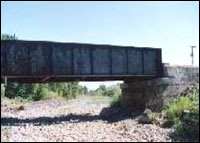
For 100 years, instream flows were way too low in the Walla Walla River until we helped launch a process that brought water back.
Photo: Waterwatch of Oregon.
Mondays in this job can begin with up to three hours of conference calls with various colleagues around the country. Topics can include work plans, the latest anti-environmental regulations released by the federal government at 4:59 p.m. last Friday, pending lawsuits, and press clips from obscure rural newspapers. Based on information from these conference calls, I can often calculate the likelihood of my chatting with the custodians sometime this week. They don’t arrive until early evening, but it’s amazing how many urgent tasks come up during a five-day period, and every so often that means a late night on the job. Still, it’ll never be like graduate school when the cleaners had time to polish the entire 12-story building and leave well after midnight … while I was still there! Never again.
Sometimes I daydream about my desk gathering dust while I spend my days working out in the field, on the rivers themselves. This isn’t just abstract fiction: I’ve had my share of rewarding outdoor-based positions in the past. But right now I am an indoors animal, emerging only at dawn and dusk to scuttle between home and work. It’s been an interesting transition, and one that many conservationists face: going indoors to preserve the outdoors. Working at home could be an appealing compromise, but the current arrangement has its own benefits too. I’m the general ecologist, a.k.a. “the science guy,” in the Northwest regional office of a national nonprofit, American Rivers. Some of the most notable distinctions between my Seattle location and American Rivers’ D.C. headquarters are that I can bike to work easily, I escape to the mountains and rivers almost every weekend, and I have an office with a door! But there are other differences.
The national office handles the lobbying, politics, and large-scale oversight of various programs and legislative issues, while the field and regional offices across the country bring things closer to the grassroots groups that keep the river movement alive. We can listen and respond to grassroots needs, taking concerns up to a national arena when necessary. Professionally speaking, the Northwest office enjoys the support, infrastructure, and reputation of a national group, while maintaining the independence to tailor projects according to local issues. For example, we spend a great deal of our time working on the recovery of endangered salmonid fish species.

Captaining the paddle raft is just part of the job.
Photo: American Rivers.
We also have more flexibility. In fact, I just helped organize our annual Northwest office river trip last week, this year on the Deschutes, a high-desert Wild and Scenic River in northern Oregon. It’s a lot tougher to do that with 40 people in the D.C. area! As it turns out, American Rivers was founded in 1973 to expand the number of waterways covered by the Wild and Scenic Rivers Act, which gives special protection to rivers and streams with remarkable natural, cultural, historical, or recreational value. Since then our work has broadened dramatically to include programs that address dam removal and operation, floodplains, the Army Corps of Engineers, instream water flows, and urban sprawl. One of the toughest things about working on water issues is deciding what not to work on. Water has some kind of role in so many ecological processes far beyond the river channel. Often, it is inextricably linked to political decisions too, and it has been identified as the most likely leading source of global and social conflict for this century. There’s a lot to do.
In this office we focus much of our energy on restoring the rivers of the Northwest for the benefit of the region’s once-magnificent Pacific salmon runs. We’re using the 200th anniversary of Lewis and Clark’s Voyage of Discovery to highlight this desperate situation and issue a call to action. Already more than a dozen Northwest fish species have been listed under the Endangered Species Act and we can’t wait any longer to reverse the loss of habitat and enhance river flows. Of the many facets of this campaign, two involve me on a day-to-day basis: Puget Sound river restoration and dam removal on the lower Snake River.
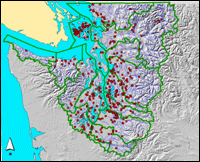
A draft map I’m working on of Pacific Northwest rivers and dams.
Thanks to skills I acquired during my graduate research at the University of Wisconsin, I’ve become quite adept at using geographic computer software that can analyze ecological data and make maps displaying the information. We are building this technology right into a new website that will contain a map of each large Northwest watershed depicting selected rivers, fish runs, dams, restoration successes, and ecological threats that we’re aware of. The site will provide a single launching point for people living in the region who want more information about their backyard rivers and how to get involved with local conservation efforts. Currently, that type of information is spread amongst dozens of unrelated federal, state, and local sites.
Well, no doubt it’s time to get Monday really rolling …
Photo of Ross used courtesy of Paul Bannick.
Tuesday, 29 Jul 2003
SEATTLE, Wash.
I can’t recall when my fascination with flowing water began, but I know that my early childhood years involved a lot of muddy riverine creations in a neighbor’s hillside flowerbed. We’d scrape out a channel, put “towns” alongside, and float hapless boats down the miniature river. Instream flows were provided by the seemingly inexhaustible garden hose. The neighbors didn’t seem to mind.
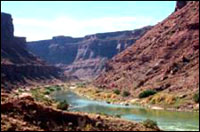
Water making its mark in Utah.
Photo: BLM.
Fifteen years later, during college, I elected to pursue a geology major because it seemed the most comprehensive and holistic natural science degree. Geography might have been the ideal choice, but my small liberal arts institution didn’t offer it. Apart from the eccentric professors, the highlight of the degree was frequent weeklong field trips traversing the Southwestern U.S. After learning about a particular geologic event or concept, we’d go on the road to see it firsthand. Over the millennia, rivers and inland seas had a particularly strong influence on the rocks that we see in the Southwest today. After enough time baking in the relentless desert sun, I came to see a river not only as creator and restless renovator of the landscape, but also as integrator of all the ecological processes occurring across it. Few living things on the planet need no water at all. Rivers became my fascination …
A river represents everything that occurs above it. If upstream users are dumping pesticides and car batteries into the water, we will see the effect downstream. If caring stewardship is the norm, all life downstream will benefit. This becomes more significant when you realize that 60 percent of this country’s population gets drinking water from lakes and rivers. Most of those same residents are downstream of other people. That can mean a lot of costly water treatment — or the cheaper alternative of simply treating watersheds sustainably. That might involve strict pollution standards, limits on clear-cut logging, reduced use of pesticides and fertilizers in agriculture, or land development that avoids the use of sprawling concrete, which funnels polluted runoff into rivers. (See our recent report on this issue: “Paving Our Way to Water Shortages.”) A handful of cities across the country have managed to protect their drinking water supplies by preventing development in the source watershed.
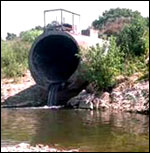
Downstream drinkers, beware.
Photo: Ohio EPA.
But what if that’s not an option? Then we turn to the regulations that protect our water. The Clean Water Act is the strongest law we have in that arena, but thanks to some incredibly shortsighted leadership in D.C., it is currently under attack. No surprise, it’s rather a complicated story! For 30 years the Clean Water Act has led to great improvements in the health of our waters by preventing unregulated pollution, wetland filling, and general destruction. Before the act was passed, raw sewage was often piped into waterways and Ohio’s Cuyahoga River even caught fire several times!
But earlier this year, the U.S. EPA and the Army Corps of Engineers announced that they plan to reassess what types of water bodies are covered by the Clean Water Act due to a recent Supreme Court decision. In the meantime, their field staff were told to stop protecting so-called “isolated” water bodies. In combination these two actions could lead to a worst-case scenario in which 20 percent of the remaining wetlands outside Alaska, and 60 percent of small streams, lose protection. And during the past few years of this administration, it has seemed that the worst case often comes true.
I’ve been working for months with D.C. colleagues and a variety of other nonprofits to craft a response to this threat. During the official comment period on the proposed changes, this coalition helped generate many of the 137,000 comments, as well as an authoritative 150-page legal and scientific response. Eighty-five stream ecologists wrote a joint letter to the EPA, and 39 states firmly objected to the idea of limiting the Clean Water Act. That may sound like overkill, but this situation may represent the biggest environmental threat in decades. We hope that all these comments will persuade the administration to drop its rulemaking effort entirely, but you always need several complementary solutions.

A coho making its way through a tiny headwater stream.
Photo: Washington Trout.
American Rivers is particularly concerned about the possible impacts to headwater streams, which often do not flow year-round. These are the small streams you might see on a hike up into the hills, or flowing through your backyard. Although they’re often narrow enough to jump across, their ecological contribution is immense. Gravity only works one way: downhill. That means eliminating protections in the headwaters will cause a mess of problems to accumulate downstream. I’ve been working for months to get some unreleased data from a source at the U.S. Geological Survey that I can use to visually portray just how widespread these small, seasonal streams are.
A fix-it bill (the Clean Water Authority Restoration Act) was introduced by Sens. Russ Feingold (D-Wis.), Barbara Boxer (D-Calif.), and Jim Jeffords (I-Vt.) in February to plug the holes in the current Clean Water Act. I spent the better part of a day urgently printing a poster-sized map I’d made of the potential threats to streams in Wisconsin and then overnighting it to Sen. Feingold for use at his press conference. We’ve also been presenting this issue to as broad an array of the concerned public as we can find — this really could affect almost everyone. Last month, I spoke with a colleague from EarthJustice at the annual meeting of the EcoJustice Working Group of the National Council of Churches, hoping to spread awareness into other constituencies. At the meeting, working group members determine their influential advocacy agenda for the following year.
While this issue still trundles forward, I haven’t devoted as much time as I should to some of my more extended projects. That’s the daily triage in this type of work. But, crises permitting, later today I hope to catch up on our innovative computer visualization of the Lower Snake River.
Wednesday, 30 Jul 2003
SEATTLE, Wash.
I often reflect on past jobs I’ve held, and the lessons from them that now travel with me. One of the positions that yielded especially lasting memories was my role as raft program manager for SPLORE, a nonprofit based in Moab, Utah, that provides outdoor trips for people with disabilities and special needs.

Practicing wheelchair transfers.
Photo: SPLORE.
For three summers, I supervised and led about 40 river trips per season, all of which provided safe but exciting outdoor experiences for a very wide range of participants. Our mission was to provide a positive venue for self-reliance, independence, and personal growth — challenging the limits that society assumes restrict individuals with disabilities. The absence of familiar constraints led to some remarkable achievements. The concept that perception equals limitation has never left me since.
In my current work, we spend a great deal of energy on public perception. What do people think about an issue? Do they even know about it? Can we change their understanding of the key problem and debunk myths that pit economic security and environmental well-being against each other? The subject of endangered salmon recovery in the Northwest frequently navigates this rocky terrain.
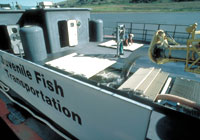
Current “fish recovery” efforts.
Photo: Army Corps of Engineers.
Over the past six months, my own work in this area has focused on an exciting new way to portray a future with an undammed, free-flowing lower Snake River. American Rivers, along with many fisheries scientists, believes that removing the lower four dams on the Snake River must be part of any successful plan to address the catastrophic drop in salmon abundance along the lower Snake River in southeast Washington. Other recovery plans that avoid dam removal have been attempted, but they have not sought to restore sustainable and harvestable populations. We believe the best way (and probably the only way) to recover abundant wild salmon and protect the river for local communities and future generations is to partially remove the four lower Snake dams, which severely limit effective salmon passage up and downstream.
Working closely with a consultant in Colorado, my task has been to create a computer visualization that portrays what the Snake might look like after dam removal. The software we’re using is produced by CommunityViz, a project of a foundation that provides tools to rural communities grappling with growth and sustainability. The end product is a photo-realistic, interactive, three-dimensional landscape model that allows stakeholders to navigate the terrain, and manipulate its features, in real time. What that means in English is that users can travel through a recognizable landscape, compare current to future visions, and chose to move architectural features as they wish. And the whole process is actually quite engaging.
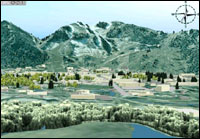
Manipulating a landscape in Colorado.
Image: CommunityViz.
Last week I spent two hours on the phone with our consultant, Lex, going over his latest work and discussing what data I needed to prepare for him next. Through some technical wizardry, I gave him control of my computer so that he could show me (from Colorado) what he was looking at on his screen. Welcome to the new millennium! We are layering aerial photos over a digital elevation model, adding streets and land cover, and then including 3D details such as buildings, bridges, and the river channel (of course).
My colleague David in our Portland office works on the programmatic side of this project, and yesterday afternoon included a lengthy conference call to make sure we have all the information we need to proceed. Currently, we’re contemplating a field visit to some of the visualization sites in order to acquire digital photos that we can drop into the model. As you might guess, this is a groundbreaking project with a lot of details to coordinate.
Yesterday also involved a long conference call with some of my colleagues in Washington, D.C., who are working hard on a new initiative, spearheaded by American Rivers and river community leaders, called the River Agenda. It’s an effort to identify some widely held goals that can become a platform for the river movement nationwide. So far, one of the issues most frequently identified by grassroots river groups is the impact of growth and development on rivers. We’ve been calling experts around the country to learn more about this topic, and yesterday we spoke to 1000 Friends of Washington about the connections between water and sprawl/growth issues. We’re looking for policy solutions at the state and federal level that could address these impacts via the River Agenda.
I sit on the board of a local nonprofit educational organization, the Homewaters Project, and last night we met after work, as we do every month, to plan out fundraising activities and outreach efforts and go over other governance issues. Our programs provide local schools with outdoor instruction centered around the connection between people and nature in their own area. We hope the students in these programs will become engaged citizens who recognize they have the power to make a difference in their communities. Now that I work on the environment from the office setting, I especially enjoy staying connected with outdoor education programs.
The calendar’s open for the rest of today, meaning that maybe I can catch up on an instream flow toolkit project, as well as the latest developments of the Habitat Conservation Plan that we’re part of in the Walla Walla River Basin. We’ll see.
Thursday, 31 Jul 2003
SEATTLE, Wash.
You can’t go very far in the Northwest without encountering water in one form or another. And I’m not just referring to the continuous eight-month rainstorm that seems to engulf the region every winter like a murky gray blanket. No, people do not rust here, but park your car long enough and it might grow a little moss. When I was growing up here, I just thought that’s how everywhere must be.
Water shows up as heavy wet snow in the high mountains; cold, clear alpine creeks; lowland rivers; and saltwater estuaries, not to mention the hundreds of miles of marine coastline. Washington’s rainfall is indeed legendary, reaching upwards of 180 inches per year in the coastal rainforest along the west face of the Olympic Range. Seattle averages about 37 inches per year, but you may be surprised to find out that large expanses of semi-desert to the east see as little as three inches annually. What I’m getting at here is that we have a diverse climate, tremendously varied topography, and therefore rivers that historically have exhibited very unruly annual fluctuations.
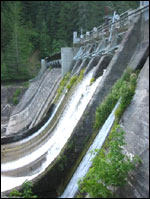
Condit Dam, White Salmon River, Wash.
Photo: Pat Boyle.
Occasional winter rain-on-snow events can produce major floods, while the spring melt typically raises river levels for weeks. By late summer, river flows often rely on groundwater entering the channel, until autumn storms begin to recharge the system. But with over 1,000 large dams clogging Washington’s waterways, we don’t see the results of these events in the river anymore. A century of tinkering has seriously affected annual flow patterns, smoothing out the peaks and troughs, and removing the natural variability that fish and wildlife evolved with.
For almost a year now, I’ve been working with a colleague at the Washington Environmental Council to write a toolkit that addresses this problem. Water is often diverted for uses like irrigation, industry, and the drinking water supply. The amount of water retained in the river for fish, wildlife, recreation, and ecological processes is called an “instream flow.” Unfortunately, in many of Washington’s 62 large watersheds, there is no instream flow at all, suggesting that all water is available for extraction. Clearly, fish might be upset about this. In those rare cases where there are established instream flows, it is often a flatline minimum across the entire year; anything above that minimum is up for grabs. But much like a patient’s vital signs, a flatline indicates that the heart has stopped.
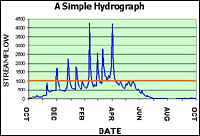
Graph: Ross Freeman.
Public watershed councils across the state are charged with setting these flows in such a way as to meet all the competing needs. These councils need help. Our toolkit will educate citizens so they can advocate for annual flows that vary based on ecological needs and indicators, rather than flows that will just barely keep the patient alive. The reputed environmental leanings of the general public here in Washington are currently well offset by a conservative state legislature; frequent explosions of bad water-related legislation have caused us a few delays in finishing the toolkit.
I had another conference call this morning with members of our staff in Washington, D.C., this time about stormwater drain systems. The subject may sound a little obscure, but, once again, rivers bear the brunt of the problem. Many municipalities across the country are facing great challenges in how to treat rainfall once it has run off from roads and buildings. As we continue to pave over our urban landscape, less water can soak into the soil, so more water ends up in overflow pipes that empty directly into rivers. Pollutants, oil spills, sediment, and fertilizers all come along for the ride. It’s a tough issue, because so much of the problem involves the very way that we build our cities.
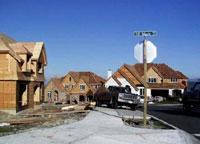
Sprawl in the Puget Sound region.
Photo: American Rivers.
We decided that some data we need can be gathered by interns, and I’m reminded of just how much work the environmental community derives from these diligent unpaid staff. In fact, this afternoon, I’ll be meeting with a prospective Northwest office intern; she may collect data on Puget Sound dams and rewrite Snake River campaign reference material. Much like many of my friends in this field, I started with a couple of internships at environmental education institutes, parlayed one into a seasonal job, and never looked back. Of course, I stalled out and spent seven years thoroughly exploring that seasonal job phase, but every position helped me see the breadth of environmental work available and clarified my desire to attend graduate school.
In my spare hours over the past few months, I’ve been making digital maps of dam locations for various regions of the country. These will be employed by our Running Rivers campaign, which negotiates changes in dam operations to achieve restoration goals. Private hydropower dams are regulated under 30 to 50 year licenses issued by the federal government, and in the next 10 years, over 400 will come up for renewal. This is a once-in-a-lifetime opportunity to seek better fish passage, spills based on ecological needs, and improvements in water quality and temperature.
Later today, I’ll be calling a media and communications company that specializes in environmental and social justice work, since we’re in the market for some educational video production. We’re also in the midst of refining our individual workplans, and if there’s any time free, I will once again turn to that task. Finally, I need to email friends and colleagues and point them to this Grist diary series so they can finally understand the work I do!
Friday, 1 Aug 2003
SEATTLE, Wash.
There’s nothing like getting out of the country to provide some perspective on your work and life. Travel abroad has a marvelous power to reconcile the necessary with the inordinate. So often we are reminded that whatever the predicament we confront at home, it will fade into obscurity compared to those faced by others on a daily basis.
I frequently encourage friends with time on their hands to go look at the United States from outside its expansive borders. While I spend time studying the best ways to dismantle dams, the largest of these structures ever known to humanity are under construction in other countries. I study the best ways to cope with polluted stormwater, while taking my clean, safe drinking water supply completely for granted.
A recent journey across Southeast Asia replenished my appreciation of the mundane and my respect for the unflappable power of the human spirit. Thanks to a fortuitous convergence of events, I managed to spend four months traversing land and sea from Indonesia to Tibet. Sure, I saw some environmental disasters, but I also witnessed numerous local efforts to improve stewardship on shoestring budgets.
Half of the countries I visited have a greater proportion of their terrain under protection than we do. The U.S. has a sound history of environmental protection; after all, we supposedly invented the idea of national parks. But now we won’t spend the money to maintain them. Congress refuses to allocate money to the Superfund program, and our country — the largest emitter of carbon dioxide on the planet — refuses to ratify the international Kyoto Protocol. We are losing ground.
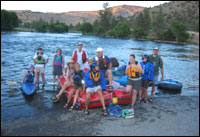
All work and no play makes river protection a little too dry.
Photo: American Rivers.
That’s why we need community more than ever: We could do with some encouragement. This past May, most of my office headed to southern Washington en masse to participate in the annual River Rally, organized by another national conservation group, River Network. The event migrates around the country and draws close to 500 participants, from backyard activists to national staffers. We attended workshops, caught up with old friends, solicited feedback on our programs, and conducted educational outreach at our booth.
Meeting people who share my fascination with flowing water and conversing with others seeking sustainable river management renewed my hope for a healthy future. After hearing so many stories about overcoming the odds, I was reminded of just how much the river movement has to be thankful for. And of course, the river trip halfway through the five-day conference didn’t hurt either! We heard a memorable lunchtime plenary by Denis Hayes, coordinator of the first Earth Day in 1970 and the first international version 20 years later. He figures that these are the most dire times the Earth has ever faced because of the potential worldwide effects of environmental mismanagement by developed nations. The assessment could have landed like a lead balloon in the midst of a rapt crowd, but instead Hayes galvanized listeners into redoubling their efforts to fight for what they believe in. It was heady stuff.
I’ve enjoyed this week of forced writing. I spent the winter of 1994 interning at High Country News, a subscription journal that covers environmental news across the Western U.S. It was a turning point for me, not only because I learned so much about good writing, but also because I saw the inner workings of the federal government. I began to realize why any positive action for the landscape took so long to bear fruit. The red tape and backdoor deals were truly impressive.
Several years later, I resolved to explore the government from the inside when I became a climbing ranger at Mt. Rainier National Park. My job was to help run the mountaineering program by issuing permits, staffing the high camps at 10,000 feet, conducting patrols to the glacier-covered summit, and running frequent search-and-rescue operations. As one of only a handful of citizens in the country getting paid by our federal government to climb mountains every day, I felt unspeakably lucky! I learned volumes about the power of human endurance and resolve. But I also saw how much inertia exists in any large federal land agency against change, large or small. Now I confront that inertia from the other side.
Today will be an abbreviated one because most of us are heading up to my coworker’s wedding in the San Juan Islands north of here. We can thank her for the half-day off, and no doubt a fun weekend ahead. It’s interesting that so many conservationists are unmarried: Of the nine staff in the Northwest office, only three have taken the plunge. This parallels what I’ve noticed at previous jobs. Perhaps the sheer intensity we throw at our careers becomes a relationship in itself? Almost by default in the Northwest, salmon will be served at the reception. But this will be wild salmon, not hatchery-raised nor farm-bred. This issue can raise hackles around here, but there are some unavoidable facts.
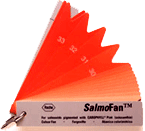
Color me salmon: a colorwheel for farmed salmon.
If we direct our energy toward rebuilding the wild fish populations that evolved here, we will also be doing the right thing for the river ecosystems that are required to support them. That’s good for everybody. Dumping truckloads of hatchery-raised fish into our Northwest rivers every year masks the decline in the wild populations and their — our — environment. It’s a bit like putting a fresh coat of paint over a rotting house: It looks good for a while, but the wood is still decaying underneath. Consumer dollars spent on wild fish make an economic statement that we value more than just the fish.
Similarly, fish farmed in floating net pens are cheap, but it comes at a steep environmental price: They produce an amazing amount of toxic waste (including antibiotics) that accumulates in the nearshore, to the detriment of other organisms. Pens in the Pacific Ocean often contain Atlantic salmon, and several hundred thousand escape every year to compete with the fish that belong here. Not to mention the fact that farmed fish are actually dyed pink so that they look like their wild cousins. Don’t worry, we won’t debate this at the wedding!
I have to admit that I’ve been arriving early every day in order to complete these diary entries, and I look forward to a slightly less crazed schedule next week. I have firm plans to excavate my desk and vigorously attack my inbox. In these challenging times, I find encouragement in the words of the conservation masters, and I leave you with a quote from Aldo Leopold: “To keep every cog and wheel is the first precaution of intelligent tinkering.”

